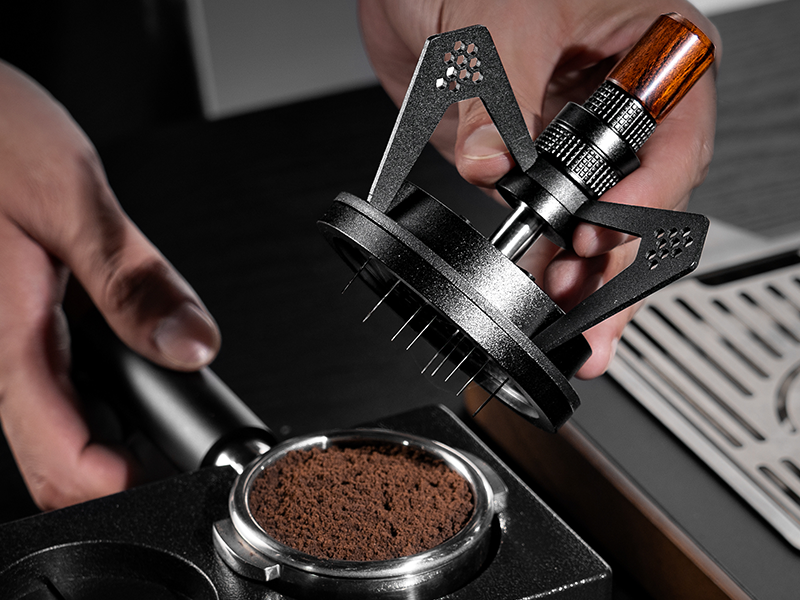1. Why Use a WDT Tool?
Core Purpose: To Address Uneven Extraction
During espresso preparation, clumps or uneven distribution of coffee grounds create pathways for water to flow through areas of least resistance (known as "channeling"). This results in over-extraction (bitterness) in some areas and under-extraction (sourness) in others. The WDT tool (Weiss Distribution Technique) uses thin needles to break up clumps, distribute grounds evenly, and eliminate density variations in the coffee puck, reducing channeling and improving extraction consistency.
2. How Does the WDT Tool Prevent Channeling?
-
Breaking Up Clumps:
-
Coffee grounds often clump due to static or oils after grinding. WDT needles separate these clumps, creating a uniform, loose bed of coffee.
-
-
Even Distribution:
-
Stirring in multiple directions (e.g., circular or radial motions) ensures consistent density across the puck, preventing overly tight or loose zones.
-
-
Reducing Fines Migration:
-
Aggressive tapping or shaking can force fine particles to settle at the bottom, blocking water flow. Gentle WDT stirring minimizes fines accumulation, optimizing water pathways.
-
3. Impact of Roast Level and Coffee Dose on Extraction
A. Roast Level
-
Light Roasts:
-
Dense, hard beans require finer grinds and higher water temperatures (e.g., 92–94°C) for proper extraction.
-
Prone to clumping due to excess fines; use thorough but controlled WDT to avoid pushing fines downward.
-
-
Medium-Dark Roasts:
-
Porous, oily beans generate more fines and static during grinding.
-
Use lighter WDT agitation to prevent over-extraction (bitterness).
-
B. Coffee Dose
-
Higher Dose (Thick Puck):
-
Increased resistance makes channeling more likely. WDT is critical here.
-
Ensure the portafilter basket matches the dose (e.g., 18g dose for an 18–20g basket) and stir down to the bottom.
-
-
Lower Dose (Thin Puck):
-
Water flows too quickly, risking under-extraction. Use WDT to evenly distribute grounds and extend contact time.
-
4. How to Choose a WDT Tool
-
Needle Thickness:
-
Ideal: 0.35–0.4mm. Thicker needles (>0.5mm) may push grounds instead of breaking clumps.
-
-
Number and Layout of Needles:
-
4–9 needles provide wider coverage and reduce dead zones. Uniform spacing is key.
-
-
Material and Durability:
-
Stainless steel needles resist corrosion and bending. Avoid 3D-printed nylon tools (prone to warping).
-
-
Ergonomic Design:
-
A comfortable handle (10–15cm length) allows vertical stirring in the portafilter.
-
DIY Alternatives:
Use sewing needles, toothpicks, or homemade 3D-printed tools, but prioritize precision and stability.
5. Pro Tips for Using a WDT Tool
-
Technique: Stir for 5–10 seconds in small circular or radial motions, covering the entire puck (including the bottom).
-
Avoid Over-Stirring: Excessive agitation forces fines downward, clogging the basket.
-
Combine with Leveling/Tamping: After WDT, lightly tap the portafilter, use a leveler, and tamp evenly.
By mastering the WDT technique, beginners can achieve balanced espresso with distinct flavor layers—bright acidity in light roasts or chocolatey depth in dark roasts.
A few reasons to recommend the IKAPE V3 Mantis springback coffee wdt tool.
1. Springback Mechanism
-
Auto-Resetting Design:
The needles automatically retract to their original position after stirring, preventing accidental disruption of the coffee puck—ideal for beginners. -
Vertical Stability:
The spring mechanism ensures needles remain perpendicular to the portafilter, avoiding uneven agitation caused by tilting.
2. Professional-Grade Needle Specifications
-
Needle Thickness (0.4mm):
Made of 0.4mm stainless steel needles, it strikes a perfect balance between clump-breaking efficiency and minimizing fines migration, aligning with the WDT "gold standard" (0.35–0.4mm). -
Needle Layout (9-Radial Configuration):
9 needles arranged in a radial pattern provide wide coverage, evenly stirring both the center and edges of the portafilter to eliminate dead zones.
3. Ergonomics and Ease of Use
-
Handle Design:
Compact, non-slip handle allows one-handed operation and effortless vertical pressure application, even in tight spaces (e.g., home coffee stations). -
Adjustable Spring Tension:
Customizable spring tension accommodates different puck depths (e.g., 20g thick pucks vs. 15g thin pucks), ensuring full-depth stirring without bottoming out.
4. Durability and Easy Maintenance
-
Full-Metal Construction:
Stainless steel needles and an aluminum alloy body resist corrosion and deformation, outperforming 3D-printed nylon tools in longevity. -
Modular Design for Easy Disassembly:
Removable needles simplify cleaning and prevent coffee grounds from clogging the spring mechanism.
5. Compatibility and Value for Money
-
Works with Most Portafilters:
Needle length (35–40mm) fits mainstream 58mm portafilter baskets (e.g., VST, IMS, OEM baskets) without needing adjustments.
6. Proven Extraction Performance
-
Reduces Channeling:
User tests show more uniform puck surfaces, stable flow rates (e.g., 36g yield in 25–30 seconds), and improved balance between acidity, sweetness, and bitterness. -
Adaptable to Roast Levels:
Adjust stirring intensity (gentle for dark roasts, deeper for light roasts) to optimize extraction and avoid over/under-extraction.
Who Should Buy It?
-
Beginners: Spring mechanism minimizes user error.
-
Advanced Users: Adjustable tension and precision needles cater to customization.
-
Convenience Seekers: Easy to clean, durable, and low-maintenance.
If your budget allows, the IKAPE V3 Springback WDT Tool is an innovative and practical upgrade for achieving consistent, café-quality espresso at home. ☕️





